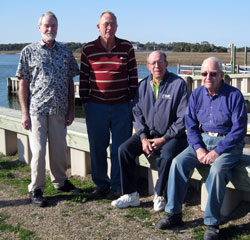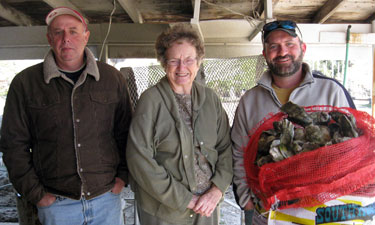Second of three parts
SUNSET HARBOR — There was a time when this little community on the Lockwoods Folly River was not quite as gentrified as it is now, recalls Miles Edge, a charter member of the Brunswick County Fishing Club. One of the oldest fishing clubs in the county, it was formed to assist boaters and to promote ethical recreational fishing practices.
Supporter Spotlight
Edge, 88, recalls when the community was mostly dirt roads and had few permanent homes. “It had a fish camp atmosphere with a lot of tents, converted school buses and trailers,” he explains. “The old boat ramp was the only access to the Lockwoods Folly River and inlet other than Varnamtown.”
 Members of the Brunswick County Fishing Club promote ethical fishing practices. Photo: Pam Smith |
The community played an important role in boater safety for several decades, adds Tom Maugans, the club’s president. “Long before cell phones and other modern communication tools, boaters relied on CB radios to communicate emergency messages to Daisy and James Butler, whose home sits near the ramp,” he says. “When they received a distress call, they would relay the information to the Coast Guard.”
One major change to the Lockwoods Folly River came in the 1930s with the construction of the Intracoastal Waterway, which crosses the river just above the inlet. During construction, the water flow through the inlet was altered by diverting the original channel and dredging and widening a new channel.
Other changes came abruptly at the hand of Mother Nature. In 1954, Hurricane Hazel’s storm surge rearranged the waterfront. The clubhouse, then an arcade, was pushed about 100 yards back from the shore to near its current location.
The most recent change in Sunset Harbor was the renovation in 2010 of the boat ramps managed by the N.C. Wildlife Resources Commission — complete with floating docks, a fishing pier and a paved parking lot with added spaces. Also, eco-friendly features include permeable paving surrounding the launch and other stormwater techniques that direct runoff away from the river and treat it.
Supporter Spotlight
The fishing club membership, once as high as 500, now hovers at about 300. The decline came with the increase in waterfront communities with their own boating facilities. The men see a correlation between the decline in fish abundance and increased shellfish closures in the river and estuary with stormwater runoff from those newly developed areas upstream along the river.
“We preach ecology with our members,” Maugans says. “We talk about the environment and how damaging the environment damages the river and its fish habitats. It’s important for people to understand the land-water connection.”
Across the River
It’s said that if you throw a rock in Varnamtown, you’re likely to hit a Varnam, a Dixon or a Galloway.
Marlene Varnam won’t dispute the point. She was a Dixon before her marriage in 1955 to Carson Varnam. Her dad was pastor of Dixon Chapel – home of the famed Annual Varnamtown Oyster Roast.
“Just about everyone’s related up and down Varnam Road,” she says with chuckle. “My husband and I grew up here. The Lockwoods Folly River provided a livelihood for us and most of the families here.”
When her husband passed away not long ago, her grandson Carson “Mickey” Fulford stepped in to help her run the business that still bears her husband’s name: Carson Varnam Seafood Market.

Alex Kwiguire, left, Marlene Varnum and Mickey Fulford of the Carson Varnum Seafood Market have no doubts that their oysters are the best on the coast. Photo: Pam Smith |
Their lives are dictated by the tide clock that hangs on a kitchen wall. At near low tide, her nephew, Alex Kwiguire, launches his boat and heads for Galloway flats. He digs for tasty treasures, oysters, until the tide rolls back in and then helps Fulford tumble, wash and bag the catch. Fulford orchestrates distribution, while Varnam handles marketing and bookkeeping.
“We have regular customers,” she says. “Some come all the way from Raleigh and Winston Salem for our fresh-from-the-river oysters.”
“That’s because Varnamtown’s fat and salty oysters are hands down the best on the coast,” Fulford says matter-of-factly.
Varnam recalls a time when there were no restrictions to when and where you could dig for oysters. Now, about two-thirds of the river is permanently closed to shell-fishing and runoff from an inch of rain conditionally closes additional areas. So, when the rain comes, they close shop until state inspectors give the green light.
Kwiguire agrees with his neighbors across the river. Stormwater runoff hotspots coincide with development patterns along the N.C. 211 corridor in the heart of the Lockwoods Folly watershed.
“When you tear one tree down, that’s one tree that’s not filtering stormwater. Development has not been good for estuaries. Oyster harvests have definitely slacked off here. Stormwater runoff washes into the river and sediments bury oyster beds,” Kwiguire asserts.
Inlet a Lifeline
 Clear passage to the ocean for the Varnumtown fishing boats is critical to the survival of the commercial fishing industry along the river. Photo Pam Smith |
Sedimentation and shoaling also contribute to Varnamtown shrimper Danny Galloway’s woes. Shallow conditions in the Lockwoods Folly Inlet mean he can’t navigate his 80-foot trawler through the inlet to the ocean.
“It’s so shallow, you can walk across the inlet,” he says. “Even small boats risk running aground at or near low tide.”
For nearly two years, he has been forced to steam up the Intracoastal to Southport and enter the Atlantic through the Cape Fear River. And, extra miles mean extra fuel costs.
While Hurricane Irene exacerbated navigation problems last year, she also precipitated the recent authorization of emergency funding from the Army Corps of Engineers for dredging this spring. That’s good news since the inlet is the lifeline for commercial and recreational boaters.
Clear passage also is critical for many fish species that travel in and out of the estuary through the inlet at various stages of their lifecycles. Sandbars that may block their passage also may cause stagnation of estuarine waters, stifling oxygen for finfish and shellfish alike.







